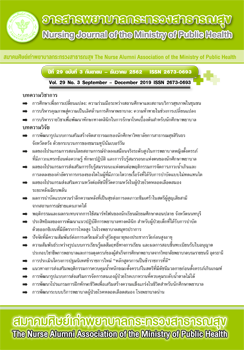ผลของโปรแกรมการสอนโดยสถานการณ์จำลองเสมือนจริงระดบั สูงในการพยาบาลหญิงตั้งครรภ์ที่มีภาวะแทรกซ้อนต่อความรู้ ทักษะปฏิบัติและการรับรู้สมรรถนะแห่งตนของนักศึกษาพยาบาล
Main Article Content
บทคัดย่อ
การตั้งครรภ์ที่ีภาวะแทรกซ้อนถือว่าเป็นความผิดปกติและเป็นอันตรายต่อหญิงตั้งครรภ์และทารกในครรภ์ความรู้และทกั ษะปฏิบัติการดูแลผู้ป่วยกลุ่มนี้จึงมีความสำคัญมาก การวิจัยกึ่งทดลองชนิดศึกษาสองกลุ่มวัดก่อนและหลังทดลองนี้มีวัตถุประสงค์เพื่อเปรียบเทียบความรู้ ทักษะปฏิบัติ และการรับรู้สมรรถนะแห่งตนในการพยาบาลหญิงตั้งครรภ์ที่มีภาวะแทรกซ้อนที่เป็นผลของโปรแกรมการสอนโดยสถานการณ์จำลองเสมือนจริงระดับสูงกลุ่มตัวอย่างนักศึกษาพยาบาลชั้นปี 4 รุ่น 46 ปีการศึกษา 2561 ใช้การสุ่มอย่างง่ายเพื่อจัดกลุ่มทดลองและกลุ่มควบคุมกลุ่มละ 40 คน กลุ่มทดลองใช้โปรแกรมการสอนโดยสถานการณ์จำลองเสมือนจริงระดับสูงที่ประกอบด้วยการทบทวนความรู้จากกรณีศึกษา การฝึกทักษะปฏิบัติการพยาบาลหญิงตั้งครรภ์ที่มีภาวะความดันโลหิตสูง ภาวะมดลูกแตก ภาวะเครียดของทารกในครรภ์ ภาวะสายสะดือย้อยในสถานการณ์จำลองเสมือนจริงระดับสูงกับหุ่นจำลองสมรรถนะสูง และการสะท้อนคิดหลังการเรียนรู้ ส่วนกลุ่มควบคุมแนะนำ การศึกษาด้วยตนเอง เครื่องมือวิจัยประกอบด้วยแบบทดสอบความรู้แบบประเมินทักษะปฏิบัติแบบประเมินการรับรู้สมรรถนะแห่งตน และแบบประเมินความพึงพอใจ เครื่องมือมีค่าดัชนีความตรง .85-1.00 ผลวิจัยพบว่ากลุ่มทดลองมีค่าเฉลี่ยคะแนนความรู้สูงกว่ากลุ่มควบคุมอย่างไม่มีนัยสำคัญทางสถิติ (t=1.663, p>.05) ทักษะปฏิบัติของกลุ่มทดลองสูงกว่ากลุ่มควบคุมอย่างมีนัยสำคัญทางสถิติ (Z=-4.911, p<.01) การรับรู้สมรรถนะแห่งตนของกลุ่มทดลองสูงกว่ากลุ่มควบคุมอย่างมีนัยสำคัญทางสถิติ (t= 2.746, p<.01) กลุ่มทดลองพึงพอใจโปรแกรมการสอนโดยสถานการณ์จำลองเสมือนจริงระดับสูงในระดับมาก ( =4.48, SD±.43) สถาบัน การศึกษาพยาบาลควรนำโปรแกรมการสอนนี้ไปใช้จัดการเรียนการสอนเพ่อื เสริมสร้างความมั่นใจในการพยาบาลหญิงตั้งครรภ์ ที่มีภาวะแทรกซ้อนให้กับนักศึกษาพยาบาล
Article Details
บทความและรายงานวิจัยในวารสารพยาบาลกระทรวงสาธารณสุข เป็นความคิดเห็นของ ผู้เขียน มิใช่ของคณะผู้จัดทำ และมิใช่ความรับผิดชอบของสมาคมศิษย์เก่าพยาบาลกระทรวงสาธารณสุข ซึ่งสามารถนำไปอ้างอิงได้
เอกสารอ้างอิง
2. Takenaka S, Matsuoka R, Maruyama D, Kawashima A, Koide K, Sekizawa A. Magnesium sulfate has an antihypertensive effect on severe pregnancy induced hypertension. Hypertension Research in Pregnancy 2016;4(1):11-5.
3. Vernekar M, Rajib R. Unscarred uterine rupture: a retrospective analysis. The Journal of Obstetrics and Gynecology of India 2016;66(S1):S51-4.
4. Kohli U, Singh S, Dey M, Bal HK, Seth A. Antenatal risk factors in emergency caesarean sections done for fetal distress. International Journal of Reproduction, Contraception, Obstetrics and Gynecology 2017;6(6):2421-6.
5. Sananpanichkul P. Update understanding and concepts of toxemia pregnancy. Journal of Prapokklao Hospital Clinic Medical Education Center 2015;32(4):364-76. (in Thai)
6. Ntlokonkulu ZB, Rula NM, Goon DT. Medium-fidelity simulation in Clinical readiness: a phenomenological study of student midwives concerning teamwork. BMC Nursing 2018;17(31):1-8.
7. Bandura A. Self-efficacy: The exercise of control. New York: W.H. Freeman and Company;1997. 8. Kolb DA. Kolb learning cycle. [Internet]. 1999.[cited 2019 July 14]. Available from: http://www.ldu.leeds.ac.uk/ldu/sddu_multimedia/images/kolb_cycle.gif
9. Jeffries PR, Rogers KJ. Theoretical framework for simulation design. In Jeffries PR.(Eds.), Simulation in nursing education: from conceptualization to evaluation, 1st ed. New York NY: National League for Nursing : 2007.
10. Faul F, Erdfelder E, Buchner A, Lang A. Statistical power analysis using G* Power 3.1: test for correlation and regression analysis. Behavior Research 2009;41(4):1149–60.
11. Kaewkanvan J, singhasivanon P. Textbook of Clinical Research: Chapter 4 Sample size in Clinical Research. [Internet]. 2011.[cited 2019 July 14]. Available from: http://www.tm.mahidol.ac.th..earh/107-44. (in Thai).
12. Pasunon P. Assessment of confidence between assessors using Kappa statistics. The Journal of Faculty of Applied Arts 2015;8(1):2-20. (in Thai)
13. Sanpasithiprasong College of Nursing. Bachelor degree Nursing Curriculum (Course Update 2012) Documents not published. (in Thai)
14. Awidia IT, Paynterb M. The impact of a flipped classroom approach on Student learning experience. Journal of Computers & Education 2019;128:269–83.
15. Li KC, Lee LY-K, Wong S-L, Yau I.S-Y, Wong B.T-M. The effects of Mobile learning for nursing students:an integrative evaluation of learning process, learning motivation, and study performance. International Journal of Mobile Learning and Organization 2019;13(1):1-3.doi: 10.1504/IJMLO.2019.096471
16. Hall SW. High-Fidelity Simulation for Senior Maternity Nursing Students. Nursing Education Perspectives 2016;36(2):124-6.
17. Franklin AE, Gubrud-Howe P, Sideras S, Lee CS. Effectiveness of Simulation Preparation on Novice Nurses’ Competence and Self-Efficacy in a Multiple-Patient Simulation. Nursing Education Perspectives 2015;36(5):324-325.doi:10.5480/14-1546
18. Young KM, Soohyun P, Jongsoon W. Influence of Nursing Students’ Anxiety during Simulation Training on Personal Satisfaction of Simulation, Self-efficacy, Clinical Competence. Journal of Korean Academy of Fundamentals of Nursing 2016;23(4):411-418. doi http://dx.doi.org/10.7739/jkafn.2016.23.4.411

